NIH findings suggest a need to consider phase of cycle when measuring cholesterol
National Institutes of Health researchers have shown that women’s cholesterol levels correspond with monthly changes in estrogen levels. This natural variation, they suggest, might indicate a need to take into account the phases of a woman’s monthly cycle before evaluating her cholesterol measures. On average, the total cholesterol level of the women in the study varied 19 percent over the course of the menstrual cycle.
In a typical cycle, estrogen levels steadily increase as the egg cell matures, peaking just before ovulation. Previous studies have shown that taking formulations which contain estrogen—oral contraceptives or menopausal hormone therapy—can affect cholesterol levels. However, the results of studies examining the effects of naturally occurring hormone levels on cholesterol have not been conclusive. According to the NIH’s National Heart, Lung and Blood Institute, high blood cholesterol levels raise the risk for heart disease.
The researchers found that as the level of estrogen rises, high-density lipoprotein (HDL) cholesterol also rises, peaking at the time of ovulation. HDL cholesterol is believed to be protective against heart disease.
In contrast, total cholesterol and low-density lipoprotein (LDL) cholesterol levels—as well as another form of blood fat known as triglycerides—declined as estrogen levels rose. The decline was not immediate, beginning a couple of days after the estrogen peak at ovulation. Total cholesterol, LDL cholesterol and triglyceride levels reached their lowest just before menstruation began. Additional information on the types of cholesterol and triglycerides is available at http://www.nhlbi.nih.gov/health/dci/Diseases/Hbc/HBC_Diagnosis.html.
The findings were published online in The Journal of Clinical Endocrinology and Metabolism.
 |
| Figure 1 The study authors found that women's total cholesterol levels rise as estrogen levels increase during the monthly menstrual cycle, drop shortly before ovulation, then decrease more rapidly after ovulation occurs. |
First author Sunni L. Mumford, Ph.D., of the Epidemiology Branch of the Eunice Kennedy Shriver National Institute of Child Health and Human Development (NICHD) and her NICHD colleague Enrique F. Schisterman, Ph.D., conducted the research with colleagues at the University of North Carolina, Chapel Hill; the State University of New York, Buffalo; and the University of Nevada Health Sciences System.
"It’s more likely cholesterol levels will be elevated in women before ovulation, which could have a particular impact on women whose cholesterol levels are already high," Dr. Schisterman said.
He explained that when a test shows a high cholesterol level, physicians will often order an additional test to make sure the reading is accurate. Testing at the end of a woman’s cycle when cholesterol levels are low might do away with the need for an additional test to confirm a high cholesterol reading.
The study compared estrogen with cholesterol and triglyceride levels among 259 healthy women between 18 and 44 years old. For 94 percent of the volunteers, researchers took 14 or more measurements over two menstrual cycles. Women charted the phases of their cycles with at-home fertility monitors, which detect hormone levels that indicate ovulation.
Most of the women were physically active and did not smoke. Only 5 percent consistently had total cholesterol levels greater than 200 mg/dL, considered borderline high-risk for heart disease. However, cholesterol levels among 19.7 percent of the women reached 200 mg/dL at least once.
A small subset of obese women over 40 showed greater fluctuation in cholesterol levels during their cycles than did the rest of the group.
"Other studies are needed to confirm our findings among obese women," Dr. Mumford said.
Further research may help clarify the optimal point in the cycle for doctors to measure women’s cholesterol levels and help clinicians develop standardized procedures for measuring cholesterol in premenopausal women and determining their heart disease risk.
###
The NICHD sponsors research on development, before and after birth; maternal, child, and family health; reproductive biology and population issues; and medical rehabilitation. For more information, visit the Institute's Web site at http://www.nichd.nih.gov/.
The National Institutes of Health (NIH) — The Nation's Medical Research Agency — includes 27 Institutes and Centers and is a component of the U. S. Department of Health and Human Services. It is the primary federal agency for conducting and supporting basic, clinical, and translational medical research, and it investigates the causes, treatments, and cures for both common and rare diseases. For more information about NIH and its programs, visit http://www.nih.gov.

 BACK TO TOP
BACK TO TOP